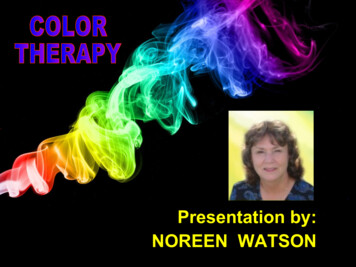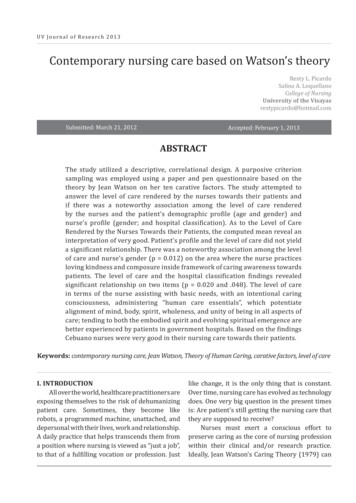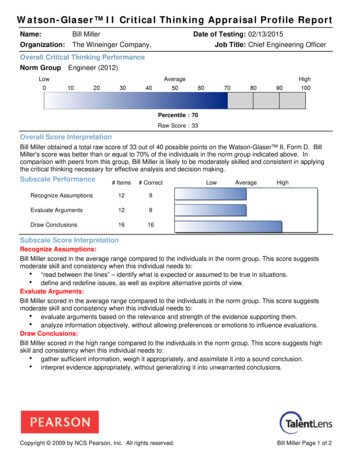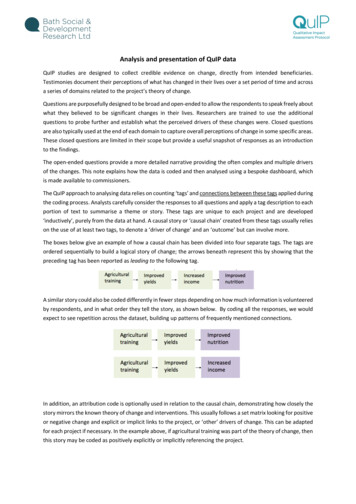
Transcription
Presentation by:NOREEN WATSON1
WHAT IS COLOR THERAPY ?Definition: a system of alternativemedicine that uses the visiblespectrum (colors) of electromagneticradiation on health disorders2
COLOR AND THE HUMAN BODYLight is electromagnetic radiation – a fluctuation of electric andmagnetic fields in nature. Every creature is engulfed in light that affectsits health. The human body came into existence from colors, the body isstimulated by colors and colors are responsible for the correctfunctioning of the body.All organs, cells and atoms exist as energy and each form has its ownfrequency or vibrational energy. Any departure from that vibratory rateresults in pathology, whereas restoring the appropriate energy levels tothe physical organs results in recovery.Colors generate electrical impulses and magneticcurrents or fields of energy that are prime activators ofthe biochemical and hormonal processes in the humanbody, the stimulants or sedatives necessary to balancethe entire system.3
THE SCIENCE OF COLORThe vibratory rate of a substance determines it’s form:1. Slowly vibrating substances make up physical matter,2. Vibration at the speed of light is subtle matter or pure light energy.Light is electromagnetic radiation, which is the fluctuation of electric andmagnetic fields in nature.The wavelength, frequency and quantity of energy of every colorfulray are fixed for each color.The human eye is sensitive to electromagnetic radiationonly at wavelengths roughly between 380 and 780 nm4
HOW THE EYE PERCEIVES COLORThe eye has two kinds of receptors, rods and cones.Cones: There are 3 million per eye concentratedin the center of the retina and areassociated with high resolution1. 64% are receptors for the color red2. 32% are receptors for the color green3. 2% are receptors for the color blueRods: 60 million – perceive white and black but notcolor and are associated with low resolution,peripheral vision but good with motion.Newton observed that color is not inherent in objects. Rather, the surface of anobject reflects some colors and absorbs all the others. We perceive only thereflected colors from objects. An object appears white when it reflects allwavelengths and black when it absorbs them all.The human eye can perceive more variations in warmer colors than cooler ones.This is because almost 2/3 of the cones process the longer light wavelengths(reds, oranges and yellows).5
THE HISTORY OF COLOR THERAPYHealing by means of color and light was the first type of therapy used byman. The sun's rays kept him warm, the colors of the flora fed him andaccounted for his mood. The Egyptian Pharaohs and the Inca Indiansworshipped the Sun as God. Egyptians and Greeks embraced color therapy.6 BC - Orpheus, in Greece utilized vibrational medicine of color and light as a means of healing125 AD - the ancient scientist, Apuleius experimented with a flickering light stimulus used to reveal epilepsy.200 AD - Ptolemy observed patterns of color rays from the sun into the eyes produced a feeling of euphoria.17th century - French psychologist Pierre Janet used flickering lights to reduce hysteria for hospital patients.1876 - Augustus Pleasanton used blue light to stimulate the glandular system.1876 - Seth Pancoast utilized red light to stimulate the nervous system.1878 - Dr. Edwin Babbitt used variant colors to produce healing of internal organs.1908 - Aura Soma developed in England used colors to heal physical and emotional symptoms.1926 - C.G. Sander specified that application of particular colors was necessary for normal health.1930 - The Father of Spectro-Chrome Metry, Dinshah P. Ghadiali compiled an encyclopedia of treatment with theuse of color and light for over 400 various health related disorders.1941 - Dr. H, - "The Syntonic Principle" - light by way of the eyes balances the autonomic nervous system.1943 - Dr. Max Lucher - psychological color testing revealed information hidden in the subconscious1980 - Dr. Thomas Budzynski - used phototherapy to accelerate learning.1991 - Dr. Harrah Conforth applied color and light to facilitate whole brain synchronization1991 - Dr. Robert Cosgrove utilized colored light for sedative properties prior to, during surgery.6
THE HISTORY OF COLOR THERAPY"The Ancient Greeks were the first to document boththe theory and practice of solar therapy.Heliopolis, the Greek city of the sun, was famous for its healingtemples, in which sunlight was broken up into its spectralcomponents (colors), and each component was used for aspecific medical problem.Color, being a manifestation of light, held a therapeutic, as well asdivine meaning for these historical cultures.“Tama Day, The healing use of light and color. Healthcare Design. February20087
THE HISTORY OF COLOR THERAPYRepairing genes:Many studies have documented that DNA, the double-helix molecule thatholds all our genetic information and guides all growth and healing in thebody, is highly responsive to light. Nina Schwalb described how lightapplied to DNA molecules makes them light up, or fluoresce, in distinctiveways. She concluded that laser light could be used to directlyrecognize and possibly repair many genetic diseases. The bodyconducts light just like telephone lines:University of Kiel.Some Russian researchers have proposed that the protein fabric of thebody acts as a fiber-optic system, as is used for telephone transmissions.Sergei Pankratov projected light on acupuncture points and was ableto measure light streaming out of other points on the body. Thesepoints were along the same meridians as where the light was introduced.He concluded that the meridians are preferential pathways for thetransmission of light in the body.Pankratov S. Meridians conduct light. Raum Zeit.8
COLOR & TERMPERAMENT 1798 Goethe & SchillerThe "rose of temperaments" (TemperamentenRose) compiled by Goethe and Schiller in1798/9. The diagram matches twelve colors tohuman occupations or their character traits,grouped in the four temperaments:choleric (red/orange/yellow):tyrants, heroes, adventurers;sanguine (yellow/green/cyan)hedonists, lovers, poets;phlegmatic (cyan/blue/violet): publicspeakers, historians, teachers;melancholic (violet/magenta/red):philosophers, pedants, rulers.9
THE COLOR WHEELColor is a very influential source ofinformation when people are makinga purchasing decision.Customers generally make aninitial judgment on a productwithin 90 seconds of interactionwith that product and about 62%90% of that judgment is based oncolor.People often see the logo of a brandor company as a representation ofthat company. Without priorexperience to a logo, we begin toassociate a brand with certaincharacteristics based on theprimary logo color.10
DINSHAH GHADIALIModern light medicine got its biggest boost from the pioneeringwork of an Indian physician named Dinshah Ghadiali. Ghadialidid a great deal of research into the use of color light forhealing after moving to New York in 1911. He trained over800 professionals between 1920 and 1924.He got his start with light medicine in India, after a youngwoman with severe diarrhea caused by colitis was rapidlycured when light from a kerosene lantern, passed throughan indigo-colored glass bottle, was shone onto her. The woman was also helped bydrinking milk that had been in an indigo-colored bottle left out in the sun. The milkapparently taking on the healing vibrations of that color of light.Over the next 20 years, his group amassed many thousands ofsuccessful case studies showing the remarkable power of lighthealing for a wide range of human diseases. As has often been the casewith innovators, Ghadiali was ordered by the FDA to shut down his teaching andequipment sales in 1947.His son, Darius, continues an educational forum called the Dinshah Health Society.11
THE INFLUENCE OF COLOR FOR YOUEXERCISE 11. On a piece of paper, write down a list of thingsthat you are working on or having challenges withthat arePhysicalEmotionalSpiritual2. As you hear things throughout this session, WRITEDOWN the colors that you think will help you.12
DINSHAH COLOR CHARTINFRA-GREENULTRA-GREENThere is logic associated with each color.13
In the book, “Let There Be Light” by Darius Dinshah, there is a bodychart showing the areas of the body by number which isreferenced when he describes using the different colors – where andhow they affect the body.14
REDPhysical: Stimulates the sensory nervous system which energizes thesenses: sight, hearing, touch, taste and smell Liver builder and stimulant for liver and stomach Builds platelets, hemoglobin, etc., of the blood (hemoglobic) Causes rapid expulsion of debris through the skin; may induceskin redness, itching, pimples, until the internal cleansingprocess is completed (irritant, pustulant) Counter-agent for cold burns from x-rays, ultra-violetFor conditions such as: Anemia, Liver problems, CirculationEmotional: Vitality, courage, passionate15
ORANGEPhysical: Lung builder and respiratory stimulants areas thyroid, breast andupper back Thyroid builder and stimulant, Parathyroid depressant Relieves cramps and muscle spasms (antispasmodic) Stimulates mammary glands to increase milk production Stomach stimulant, areas spleen, liver, stomach (stomachic) Assists vomiting when stomach contains unsuitable matter. Relieves flatulence or gas in the digestive tract (mid and lowerabdomen) Bone builder, corrects bone softness, rickets, by calcium effect Tissue stimulant decongestantFor conditions such as: Muscle or menstrual cramps, Gastritis,NauseaEmotional: Joy, confidence, resourceful16
YELLOWPhysical: Stimulates the motor nervous system which energizes the muscles.Nerve builder for sensory and motor systems. Stimulates the lymphatic system. Mild tissue stimulant Stimulates the intestines, pancreas, and production of digestivefluids – bile, hydrochloric acid, etc. Increases bowel movements Spleen depressant; equilibrator in melancholia, balances areas ofspleen and liver through the portal circulation. Expels worms and parasitesFor conditions such as: Diarrhea, Parasites, Mental disordersEmotional: Happy, clarity, strong self esteem17
LEMONPhysical: Produces a favorable change in the processes of nutrition andrepair in persistent disorders (chronic alterative) Dissolves bloodclots. Promotes coughing to expel mucus and fluids from the lungs andair passages Bone builder, by phosphorus effect Brain stimulant Thymus builder and stimulant Mildly stimulates digestive system (laxative) Equilibrator after extended use of ultra-Green tonationsFor conditions such as: Cancer, Constipation, Fatigue, HypertensionEmotional: Hopeful, restless, excitable18
GREENPhysical: Cerebral equilibrator. Physical equilibrator, systemic front Pituitary stimulant and equilibrator (area: face) Stimulated the rebuilding of muscles and tissues Destroys microorganisms, germs, bacteria; cleanses and preventdecay (germicide, bactericide, disinfectant, antiseptic)For conditions such as: Colds, Flu, Sinusitis, Food poisoning, ArthritisEmotional: Calm, alert, sensitive, jealous19
TURQUOISEPhysical: Produces a favorable change in the processes of nutrition andrepair in recent disorders (acute alterative) Brain depressant Skin tonic. Rebuilds burned skin Equilibrator after extended use of infra-Green tonations.For conditions such as: Burns, Hyperacidity, Neuralgia, Insect bites,RashesEmotional: Easy going, enthusiastic, creative, sensitive, over orunder emotional20
BLUEPhysical: Relieves itching, and irritation of abraded surfaces Encourages perspiration Mild sedative. Reduces or removes fever and inflammation Pineal stimulant (area: face) Builds vitality.For conditions such as: Hot Burns, Cough, Sunburn, Arthritis,RashesEmotional: Cool, calm, peaceful, relaxed21
INDIGOPhysical: Parathyroid builder and stimulant (area: thyroid) Thyroid depressant Respiratory depressant Causes contractions, controls abscesses, lessens secretions,arrests discharges and hemorrhages (astringent) Promotes the production of phagocytes which destroy harmfulmicro-organisms, bacteria, germs, etc. Mammary depressant – reduces milk production Eases suffering, lessens excitement and over-activity (sedative)For conditions such as: Viruses, Toothache, Bruises, EczemaEmotional: Reflective, need for recognition, organized, devoted.22
VIOLETPhysical: Spleen builder and stimulant Decreases muscular activity, including the heart muscles Lymphatic glands depressant, systemic front. Pancreasdepressant (area: stomach, middle back) Decreases activity of the nervous systems (tranquilizer) Promotes production of leucocytes, white (violet) blood cells.For conditions such as: Emotional stress, Fibromyalgia, LupusEmotional: Compassionate, imaginative, selfless23
PURPLEPhysical: Kidney and adrenal depressant (area: middle back) Decreases sensitivity to pain. Induces relaxation and sleep Increases functional activity of the veins Lowers blood pressure by three effects: dilates blood vessels,reduces the heart rate (area: breasts), decreases activity of thekidneys and adrenals (area: middle back) and the chromaffic system,systemic front and back Lowers body temperature, Controls fever and high blood pressure inmalaria and recurrent fevers Emotional and reproductive system depressant. Builds sex powersby decreasing sensitivity and desire when excessive Moderates blood pressure between heart and lungs.For conditions such as: Asthma, Migraine, Hard Arteries, HypertensionEmotional: Spiritual, wise, mysterious24
MAGENTAPhysical: Emotional equilibrator and auric builder, systemic front. Builds and equilibrates the functional activity of heart, bloodcirculatory system, Kidneys and adrenals, the chromaffiin system,systemic front and back, reproductive system, kidneysFor conditions such as: Edema, Inflammation, ArrhythmiaEmotional: Sensible, cooperative, sometimes impulsive and
THE HISTORY OF COLOR THERAPY "The Ancient Greeks were the first to document both the theory and practice of solar therapy. Heliopolis, the Greek city of the sun, was famous for its healing temples, in which sunlight was broken up into its spectral components (colors), and each component was used for a specific medical problem. Color, being a manifestation of light, held a therapeutic, as well .











